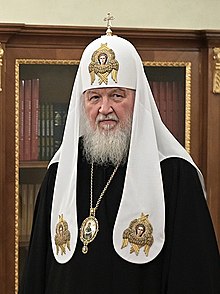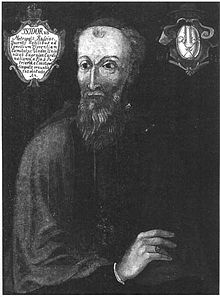| Patriarch of Moscow and all Rus' | |
|---|---|
| Bishopric | |
| Eastern Orthodox | |
 | |
 Monogram of Patriarch Kirill Monogram of Patriarch Kirill | |
| Incumbent: Patriarch Kirill Since 1 February 2009 | |
| Style | His Holiness |
| Location | |
| Residence | Patriarchal Residence in Chisty Lane Patriarchal and Synodal Residence in Danilov Monastery |
| Information | |
| First holder | Job |
| Established | 1589 |
| Cathedral | Cathedral of Christ the Saviour and Epiphany Cathedral at Yelokhovo |
| Website | |
| patriarchia | |
The Patriarch of Moscow and all Rus' (Russian: Патриарх Московский и всея Руси, romanized: Patriarkh Moskovskiy i vseya Rusi), also known as the Patriarch of Moscow and all Russia, is the title of the primate of the Russian Orthodox Church. It is often preceded by the honorific "His Holiness". As the ordinary of the Diocese of Moscow, the office holder's direct canonical remit extends only to Moscow; however, as Patriarch, the office holder has a number of church-wide administrative powers as laid down by the charter of the Russian Orthodox Church.
The patriarchate was established in Moscow in 1589: the first patriarch was Job. The patriarchate was abolished in 1721 by Peter the Great and replaced with the Most Holy Synod, before being restored on 10 November [O.S. 28 October] 1917, by decision of the All-Russian Local Council. The current patriarch is Kirill, who acceded to the position on 1 February 2009.
Etymology
Different variations of the title, including "Patriarch of Moscow and All Russia", "Patriarch of Moscow and all the Great, and Small, and White Russia", and others have been used. The modern form, "Patriarch of Moscow and all Rus'", was initially used in 1589 (when the see was elevated to patriarchate) through 1721 (when abolished by Peter the Great). The current version of the title was restored beginning in 1917 until suspended by Soviet authorities in 1925, and since being reinstated with the election of Metropolitan Sergius as patriarch in 1943.
History
See also: History of the Russian Orthodox Church
The church has its origins in the Metropolis of Kiev and all Rus' that was erected on the territory of Kievan Rus'. It existed between 988 AD and 1596 AD. Canonically, it was under the jurisdiction of the Ecumenical Patriarchate of Constantinople. The episcopal seat (cathedra) was located in the city of Kiev. In 1325, Metropolitan Peter moved the episcopal seat from Vladimir to Moscow.
Following the Union of Florence, the Grand Prince of Moscow — Vasily II of Moscow — voided the union in his lands and imprisoned Metropolitan Isidore of Kiev for some time. Having adjudged Isidore to have apostatized to Catholicism, he was deposed by a local synod. After the metropolitan throne lay vacant for seven years, the secular authorities replaced him with Jonah of Moscow. Like his immediate predecessors, he permanently resided in Moscow, and was the last Moscow-based primate of the metropolis to keep the traditional title with reference to the metropolitan city of Kiev. He was also the first metropolitan in Moscow to be appointed without the approval of the Ecumenical Patriarch of Constantinople as had been the norm.
Constantinople–Moscow schism
Main article: 15th–16th century Moscow–Constantinople schismIn 1448, Jonah unilaterally changed his title to Metropolitan of Moscow and all Russia. This signified the beginning of the de facto independence (autocephaly) of the Moscow (north-eastern) part of the Church.
Meanwhile, in the lands of the Grand Duchy of Lithuania and the Kingdom of Poland, the rulers continued to recognise Isidore as metropolitan; Jonah was rejected and was unable to exercise any pastoral control beyond the borders of Muscovy. The metropolis continued to operate beyond Muscovy under the mother church of the Ecumenical Patriarchate with the revised title of Metropolitan of Kiev, Galicia and all Rus'.
Regularisation of the canonical status
In 1589, Jeremias II, the Patriarch of Constantinople, regularized Moscow's canonical status and raised Job to the status of patriarch.
In 1685, the western part of the former metropolis that was situated in the Polish–Lithuanian Commonwealth was transferred from the Ecumenical Patriarchate of Constantinople to the Moscow Patriarchate as the Metropolis of Kiev. It is a matter of dispute as to whether Moscow abided by the terms of the transfer.
Disestablishment by the state
Further information: Church reform of Peter the GreatUpon the death of Patriarch Adrian in 1700, Peter I did not permit the election of a new patriarch; after 20 years he established a Theological College, soon renamed the Most Holy Synod, which, as a public body, acted as the general church administration from 1721 to 1917. The emperor (to 2 March 1917) was "the highest judge of the assembly." This completed the transformation of the Moscow Patriarchate into a Caesaropapist entity that was under the control of the Russian state.
Restoration
The Patriarch of the Russian Orthodox Church was restored by decision of the All-Russian Local Council on 28 October (11 November) 1917. The first patriarch elected after restoration was Patriarch Tikhon, Metropolitan of Moscow.
Selection
According to the Charter of the Russian Orthodox Church adopted in 2000, the tenure of a patriarch is for life, and the right to trial a deposed patriarch as well as the question of his retirement belong to the Council of Bishops.
Between terms, the Holy Synod of the Russian Orthodox Church elects the chair from among its permanent members of the locum tenens of the Patriarchal throne. "Not later than six months after the release of locum tenens of the patriarchal throne, and the Holy Synod of the local council ... shall convene to elect a new Patriarch of Moscow and all Rus'."
The candidate for the patriarch must be a bishop of the Russian Orthodox Church, not younger than 40 years old, have a "higher theological education, the expertise of the diocesan administration".
The procedure for the election of the patriarch of the charter was not detailed, "place-holder establishes the procedure for electing the Holy Synod". In 2011, the Presidium of the Inter-Council Presence reviewed the draft document "The procedure and criteria for the election of the Patriarch of Moscow and all Rus'" and decided to send it to the diocese for comment and publish the discussion. In the 20th century, Metropolitan Tikhon as patriarch was elected by lot from the three pre-approved for the Local Council candidates; between rigid state control over the affairs of the Russian Orthodox Church Sergius, Alexy I and Pimen were elected uncontested open vote on the approval of the government.
Alexius II was elected to the Local Council in 1990 by secret ballot in the first round, which was attended by three candidates approved by the Council of Bishops earlier (and local council had the right to add to the list of new candidates), and the second — the two candidates with the most votes in the first round.
Kirill I was elected on 27 January 2009 by the ROC Local Council (the 2009 Pomestny Sobor) as Patriarch of Moscow and all Rus' and Primate of the Russian Orthodox Church, with 508 votes out of 700. He was enthroned on 1 February 2009. The Patriarch enters the dignity during a special ceremony of enthronement, which is held a few days after the election.
See also
Notes
- The Grand Duchy of Moscow was a predecessor state of current state called the Russian Federation.
References
- "О епархии, "about the diocese"". Russian Orthodox Church. Retrieved 2021-08-02.
- Устав Русской Православной Церкви (принят на Архиерейском Соборе 2000 г.; Определениями Архиерейских Соборов 2008 и 2011 гг. в текст Устава был внесен ряд поправок) // IV. Патриарх Московскийи всея Руси. Archived February 24, 2013, at the Wayback Machine
- ^ "Local Council of the Russian Orthodox Church". Retrieved 3 March 2016.
- "Metropolitan Sergius elected the Patriarch of Moscow and All Russia". Retrieved 3 March 2016.
- Russia: People and Empire, 1552–1917 by Geoffrey Hosking, Harvard University Press, 1998, ISBN 0674781198 (page 46)
- Russia and The Commonwealth of Independent States 2012 by M. Wesley Shoemaker, Stryker Post, 2012, ISBN 1610488938 (page 10)
- ИОНА // Orthodox Encyclopedia
- E. E. Golubinskii, Istoriia russkoi tserkvi (Moscow: Universitetskaia tipografiia, 1900), vol. 2, pt. 1, p. 469.
- Paul Bushkovitch (27 September 2001). Hieromartyr Tikhon. p. 221. ISBN 9781139430753. Retrieved 3 March 2016.
- Bainton, Roland H. (1966), Christendom: A Short History of Christianity, vol. I, New York: Harper & Row, p. 119
- "Hieromartyr Tikhon". Retrieved 3 March 2016.